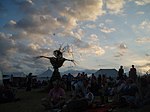Hardwick Hall

Hardwick Hall in Derbyshire is an architecturally significant country house from the Elizabethan era, a leading example of the Elizabethan prodigy house. Built between 1590 and 1597 for Bess of Hardwick, it was designed by the architect Robert Smythson, an exponent of the Renaissance style. Hardwick Hall is one of the earliest examples of the English interpretation of this style, which came into fashion having slowly spread from Florence. Its arrival in Britain coincided with the period when it was no longer necessary or legal to fortify a domestic dwelling. After ownership for centuries by the Cavendish family and the line of the Earl of Devonshire and the Duke of Devonshire, ownership of the house was transferred to the Treasury in 1956 and then to the National Trust in 1959. The building was ruinous and required stabilisation and a subsequent restoration.The Hall is fully open to the public and received 298,283 visitors in 2019.
Excerpt from the Wikipedia article Hardwick Hall (License: CC BY-SA 3.0, Authors, Images).Hardwick Hall
Stableyard Footpath,
Geographical coordinates (GPS) Address Nearby Places Show on map
Geographical coordinates (GPS)
| Latitude | Longitude |
|---|---|
| N 53.1688 ° | E -1.3088 ° |
Address
Hardwick Estate Gardens
Stableyard Footpath
S44 5QJ
England, United Kingdom
Open on Google Maps









